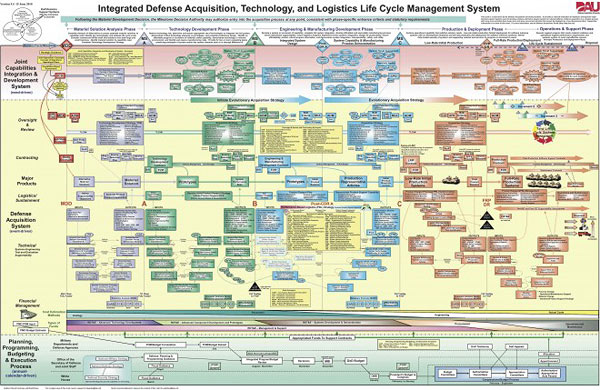In this blog post, defense technology reporter Noah Shachtman tries to make sense of a Powerpoint chart "which documents the Defense Department's bazillion-step process to developing, buying, and maintaining gear."
innovation DAILY
Here we highlight selected innovation related articles from around the world on a daily basis. These articles related to innovation and funding for innovative companies, and best practices for innovation based economic development.
Gentleman lives on floating plastic bottle island home
Mr. "Rishi" Sowa lives on an floating island. That he made. From empty plastic bottles and a few mangrove plants. In Mexico.
From the blog:
From 1998 to 2005, Rishi Sowa hand-built and lived on the first Spiral Island, which floated on over 300,000 recycled bottles! It was destroyed by Hurricane Emily in 2005. Rishi has now built an even better island at Isla Mujeres, Mexico, in a lagoon which offers shelter from bad weather! Rishi will continue to make improvements to the Island, so it will always be a eco-work-of-art in progress!
Rolf Potts is traveling around the world with no luggage
 In a recent Boing Boing guest post, I talked about Neo-Minimalism and the rise of the Technomads. Both terms describe a wide array of practices relating to reducing the stuff you own and becoming more mobile.
In a recent Boing Boing guest post, I talked about Neo-Minimalism and the rise of the Technomads. Both terms describe a wide array of practices relating to reducing the stuff you own and becoming more mobile.
In what is potentially the most minimal "technomadic" experiment ever, Rolf Potts (author of one of my favorite travel/lifestyle books Vagabonding) has set out on 6-week, 12-country, round-the-world trip without a single piece of luggage.
His trip is sponsored by ScotteVest (covered frequently here in the past), and yes, it's kind of a stunt. But it's also a super interesting experiment in travel minimalism. Exactly how much do you need to bring with you to get by on a trip like this?
Seedcamp Week: Europe Fires Up The Warp Drive For The Enterprise
 Seedcamp, the roving pan-European startup programme which seems to have the momentum of a juggernaut these days, kicked off its big week this week in London at University College London with a record number of teams, 23 this year picked from 900 applicants, and over 100 mentors taking to teams from 16 regions throughout EMEA. And already there are general themes emerging from the teams presenting.
Seedcamp, the roving pan-European startup programme which seems to have the momentum of a juggernaut these days, kicked off its big week this week in London at University College London with a record number of teams, 23 this year picked from 900 applicants, and over 100 mentors taking to teams from 16 regions throughout EMEA. And already there are general themes emerging from the teams presenting.
Saving businesses money is one major theme – important in a recession. Plus, fashion startups are a trend in their own right as they start to address the rather antiquated fashion world. “Data” startups are also a trend, and the problems of the media world are also being addressed.
Ron Conway’s Confidential Investment Guide: The Tech Megatrends
 Angel investors SV Angel, led by Ron Conway invests so early in startups that he looks mostly at the team and current tech trends when making investment decisions.
Angel investors SV Angel, led by Ron Conway invests so early in startups that he looks mostly at the team and current tech trends when making investment decisions.
Last year he was focusing on real time and location startups. This year, according to a confidential report to SV Angel investors that made its way into our hands, he’s looking at a whole slew of trends.
How a startup plays into these trends is taken into consideration when SV Angel ponders an investment. The trends include:
- Social
- Real Time
- Location Based Services
- The Urban Entrepreneur
- Mobile
- Flash Sales
- Behavior & Transactions
Boosting the productivity of knowledge workers
 Are you doing all that you can to enhance the productivity of your knowledge workers? It’s a simple question, but one that few senior executives can answer.
Are you doing all that you can to enhance the productivity of your knowledge workers? It’s a simple question, but one that few senior executives can answer.
Their confusion isn’t for lack of trying. Organizations around the world struggle to crack the code for improving the effectiveness of managers, salespeople, scientists, and others whose jobs consist primarily of interactions—with other employees, customers, and suppliers—and complex decision making based on knowledge and judgment.1 The stakes are high: raising the productivity of these workers, who constitute a large and growing share of the workforce in developed economies, represents a major opportunity for companies, as well as for countries with low birthrates that hope to maintain GDP growth.
Prescription for a Healthier Brain: Coffee and Cigarettes?
 Inspired by human studies showing that avid coffee drinkers and smokers
have a lower risk of Parkinson’s disease, scientists at the University
of Washington decided to see what java and cigarettes do to fruit flies.
The tremors and other movement impairments of Parkinson’s are triggered
by the death of dopamine-producing cells in the brain, so the
investigators used flies that had been genetically engineered to have
their dopamine cells die off as they age. When Leo Pallanck and his
colleagues fed coffee and tobacco extracts to these flies, they found
that the animals’
dopamine cells survived and their life span increased. The scientists
ruled out caffeine and nicotine as the protective substances, but there
are other promising compounds in coffee and tobacco, which the
researchers intend to test in these short-lived creatures. “Flies are a
great system for quickly trying to zero in on the chemicals that are
responsible,” Pallanck says.
Inspired by human studies showing that avid coffee drinkers and smokers
have a lower risk of Parkinson’s disease, scientists at the University
of Washington decided to see what java and cigarettes do to fruit flies.
The tremors and other movement impairments of Parkinson’s are triggered
by the death of dopamine-producing cells in the brain, so the
investigators used flies that had been genetically engineered to have
their dopamine cells die off as they age. When Leo Pallanck and his
colleagues fed coffee and tobacco extracts to these flies, they found
that the animals’
dopamine cells survived and their life span increased. The scientists
ruled out caffeine and nicotine as the protective substances, but there
are other promising compounds in coffee and tobacco, which the
researchers intend to test in these short-lived creatures. “Flies are a
great system for quickly trying to zero in on the chemicals that are
responsible,” Pallanck says.
Getting Your Startup Website Ready, Pre-Launch
 Even if you're not quite ready to show the
public your product, you can still create a good website and a solid
online presence for your startup. I want to sidestep the argument about
whether or not it's good to be "stealth" or not, and work with the assumption that if you've purchased the domain name, you're going to put up some sort of website.
Even if you're not quite ready to show the
public your product, you can still create a good website and a solid
online presence for your startup. I want to sidestep the argument about
whether or not it's good to be "stealth" or not, and work with the assumption that if you've purchased the domain name, you're going to put up some sort of website.
So here are a few of the things you should consider when building your startup's site:
1. Have a nice "look"
You don't have to commit to the whole graphical "look and feel" of your brand on day one, but you do want to to make moves in that direction. Even if your site starts as an announcement for "more information coming soon," you can still have a visually striking site.
What Does a Headhunter Really Look For?
 Freud had a pretty smooth gig. Here was a man who enticed wealthy, neurotic women to his office and — relaxing their inhibitions with hypnosis — encouraged them to describe their fantasies while lying on his chaise lounge. As if that wasn’t enough, he profitably published these sessions…and then billed them. Still, he didn’t completely get it.
Freud had a pretty smooth gig. Here was a man who enticed wealthy, neurotic women to his office and — relaxing their inhibitions with hypnosis — encouraged them to describe their fantasies while lying on his chaise lounge. As if that wasn’t enough, he profitably published these sessions…and then billed them. Still, he didn’t completely get it.
We have the same problem lately with leadership. It’s the hottest topic for business books of every shape and flavor, yet despite all the “five qualities this” and “seven characteristics that,” we still don’t get it, either. Honestly, isn’t it a bit like pornography? We know it when we see it.
Top 25 Universities for Corporate Job Search
Think graduating from an Ivy League school will generate great corporate job offers? Now could be the time to rethink this  job search strategy.
job search strategy.
Job recruiters from major corporations such as Google, General Electric, Campbell Soup and others from nearly 30 industries are reporting that large state universities have become their favorite places to find new college grad hires.
Penn State, Texas A&M and the University of Illinois are among the hot spots for job recruiters, whose companies recently hired 43,000 new college graduates.
A Wall Street Journal survey, which was conducted along with PayScale and Cambria Consulting, a human resource firm, uncovered the job search favoritism of corporate job recruiters.
Common Interview Questions and How to Answer Them
 If you are smart, you have already studied up on how to be great in
an interview. You know what to wear, how to walk, and you studied the
answers to the common questions. There are three questions, however,
that are so obvious, so common that most people never think to study for
them.
If you are smart, you have already studied up on how to be great in
an interview. You know what to wear, how to walk, and you studied the
answers to the common questions. There are three questions, however,
that are so obvious, so common that most people never think to study for
them.
Yet they are also the hardest questions you’ll get.
1. Tell me about yourself?
This is not a literal question. This is a question for you to give framework to the interview. You will tell the person what is important to you, what she should talk with you about, and, most importantly, you will tell it to her in a story that she can remember, and relay to other people. You need to be interesting here, so don’t just list your jobs and duties like this is a verbal version of your resume. This is a time for you to turn your life history into a story that leads seamlessly into this job being the obvious next step for you.
How web video powers global innovation
TED’s Chris Anderson says the rise of web video is driving a worldwide phenomenon he calls Crowd Accelerated Innovation — a self-fueling cycle of learning that could be as significant as the invention of print. But to tap into its power, organizations will need to embrace radical openness. And for TED, it means the dawn of a whole new chapter …
If You're In The Internet Business And You Don't Watch This Sean Parker Video, You Might As Well Quit Right Now
Small Businesses Are Seeing "Recession, Recession, Recession"
 The latest NFIB small business survey is out, and it shows a very small uptick in optimism.
The latest NFIB small business survey is out, and it shows a very small uptick in optimism.
But the head of the NFIB on CNBC sounds very gloomy. He notes that the optimism index is still below 90, signaling "recession, recession, recession" and that it basically comes down to this: small businesses aren't seeing sales.
It's as simple as that, really.
"There is no life in the job market."
He's also making some very interesting points about bank lending, and plans to cut taxes to small business. Basically he says it's pointless because the sales aren't there, so there's just no reason to invest in anything.
Recession Hammers US Entrepreneurs According To Global Entrepreneurship Monitor Research; Dogged Determination Is Necessary To Survive
 U.S.
entrepreneurial activity fell significantly from 10.6% in 2005 to 6.9%
in 2009, according to the “Global Entrepreneurship Monitor (GEM) 2009
National Entrepreneurial Assessment for the United States of America,”
conducted by Babson College and Baruch College.
U.S.
entrepreneurial activity fell significantly from 10.6% in 2005 to 6.9%
in 2009, according to the “Global Entrepreneurship Monitor (GEM) 2009
National Entrepreneurial Assessment for the United States of America,”
conducted by Babson College and Baruch College. - Early-stage fell from 8.7% to 6.9%;
- Established declined from 7.7% to 5.7%;
- Opportunity-driven declined from 7.2% to 4.8%.
- Only necessity-driven entrepreneurs increased. (As the economy sheds jobs, more individuals start businesses to sustain themselves.)
U.S SMALL BUSINESS REACHES INNOVATION GLASS CEILING
 Herndon, VA – Sep 13, 2010 – U.S. small businesses, typically known
as the innovation engine that fuels the nations’ economic growth, have
reached a roadblock when it comes to marketing innovation. Contrary to
the optimistic outlook in 2009, the fourth wave of the Small Business Success Index™ (SBSI), sponsored by Network Solutions® and the Center for Excellence in Service at the University of Maryland’s Robert H. Smith School of Business,
indicates that the recession is stifling small business owners from
pushing the limits on innovative marketing. Only 37% of small
businesses say they are highly successful at coming up with new ideas to
grow their business compared to 47% last year.
Herndon, VA – Sep 13, 2010 – U.S. small businesses, typically known
as the innovation engine that fuels the nations’ economic growth, have
reached a roadblock when it comes to marketing innovation. Contrary to
the optimistic outlook in 2009, the fourth wave of the Small Business Success Index™ (SBSI), sponsored by Network Solutions® and the Center for Excellence in Service at the University of Maryland’s Robert H. Smith School of Business,
indicates that the recession is stifling small business owners from
pushing the limits on innovative marketing. Only 37% of small
businesses say they are highly successful at coming up with new ideas to
grow their business compared to 47% last year.
“Creative thinking and the determination to push the limits on innovation are the hallmark characteristics of entrepreneurs,” says Tim Kelly, CEO, Network Solutions, an advocate of small business success. “Having a strong presence on the Web gives business owners a great launch pad to showcase their innovative spirit and build brand awareness for the products and services they offer.”
Fifteen steps to an Innovation Economy
 Developed by New York Academy of Sciences, The Yaroslavl Roadmap 10-15-20 describes the innovation policies, successes, and challenges of four countries—Israel, Finland, India, and the U.S.—and Taiwan Province, China. Based on analyses of how those regions developed innovation economies, and on a study of the current state of Russia’s economy compared to the priorities of President Medvedev, the report offers 15 specific recommendations. It also highlights 20 pitfalls for Russia to avoid.
Developed by New York Academy of Sciences, The Yaroslavl Roadmap 10-15-20 describes the innovation policies, successes, and challenges of four countries—Israel, Finland, India, and the U.S.—and Taiwan Province, China. Based on analyses of how those regions developed innovation economies, and on a study of the current state of Russia’s economy compared to the priorities of President Medvedev, the report offers 15 specific recommendations. It also highlights 20 pitfalls for Russia to avoid.
The blueprint and learnings could equally be relevant to India. Even though India figures as one of the countries studied here, the gaps are very evident.
The Surest Way to Destroy an Innovation Initiative
 There are three, and only three, models for organizing innovation that work.
There are three, and only three, models for organizing innovation that work.
The first is the "turn the masses loose" model, also known as the "innovation is everyone's job, every day" model. It works, to a point. With proper motivation, you can get a huge number of small projects done. But the limitation to this approach is significant and easy to see: People are busy. They have day jobs, and once their day-to-day responsibilities are complete, there's little left — time, energy, motivation — for innovation. You may get 5% of Larry's time plus 5% of Mary's time and so on, but slivers of free time are difficult to aggregate beyond a few people, and make it hard to get anything substantial done.
The second model could be called the "make innovation repeatable" model. In this approach, innovation is treated no differently than any other business process. You document each step. You define clear roles and responsibilities. You measure. You hold people accountable. Companies that routinely bring out new products and services are familiar with this model, and it works, but really only for incremental improvements to existing products. When your innovations are making sharp breaks from the past, the carefully designed innovation process, which relies on repeatability, breaks down.



 Every young entrepreneur is strapped for cash yet looking for all the same products and services that big companies use.
Every young entrepreneur is strapped for cash yet looking for all the same products and services that big companies use.